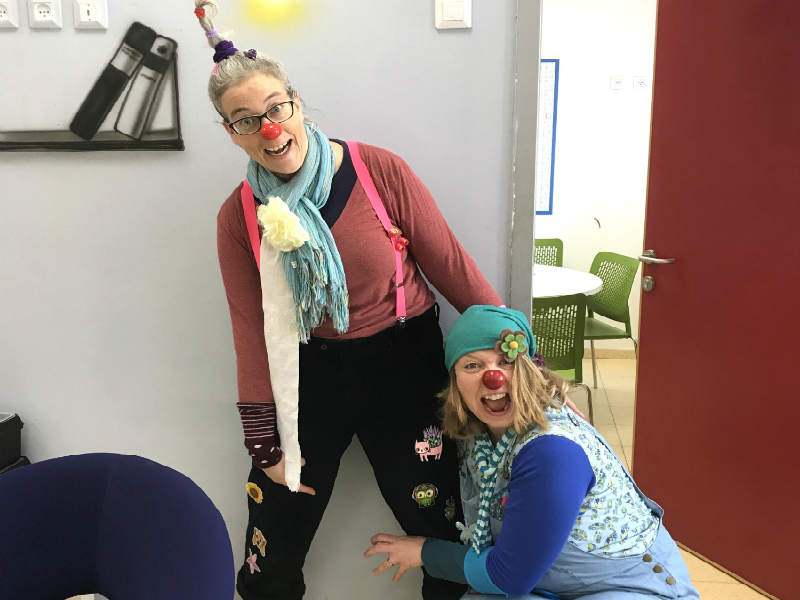Every recess, 12th graders Maya and Shir sit on the same bench facing the basketball courts in the school yard. They have no desire to partake in sporting activities. They are socially awkward, and have become outcasts somewhat because of it. But once a week they get a chance to transfer their underdog standing when a group of ridiculous looking adults, dressed in polka dots and stripes with red rubber noses, take on the role of the school’s most humiliated and embarrassed individuals.
Therapeutic medical clowning has become an integrated component of adult and pediatric care in medical centres worldwide. But in Israel, a new sector of clown care therapy is growing – educational clowning.
During the 2017-2018 school year, I decided to dedicate my Fridays to learning the art of therapeutic clowning at the Kibbutzim College of Education, Technology and the Arts in Tel Aviv under Talia Safra, a medical clown since 2003 and instructor since 2000. In mid-2018, I joined the Educational Clowning Initiative, which brings therapeutic clowns into the school system.
Thirty years since I left grade school, I’m back roaming the halls and stairways, visiting classrooms and teachers’ rooms, exploring courtyards and other areas of schools. This time around, I’m not stressed about marks or worried about friends, and I don’t care if I’m trendy or fashionable enough. My clown name is Oshi, and I’m there to infuse fun and good.
When I saw Maya and Shir one recent Monday, they were sitting on their bench. No one seemed to pay any attention to them and they kept a low profile. But this day was going to be different for them even if they didn’t know it yet. Today, they would get to decide whether to welcome or reject some social misfits. It was their turn to be the decision makers, to tell others what to do.
One of my educational clown colleagues, Bobo, approached them first and asked if she could sit beside them. They refused and told her to go off in another direction. She did. And they both showed elation that Bobo did what they asked her to do. I approached second but did not speak to them right away. I knelt down in front of them. We had a silent staring exchange. Educational clowning is about making yourself as low as possible on the social status scale, and lifting up those around you. I literally gave them the feeling that they were above me.
The ice was broken. I asked them to tell me about school life from their perspective. They told me their grievances, which classes they liked and didn’t like, how they felt being at school. For educational clowns there are no scripted performances – it’s all about awareness, improvisation, listening and absurdity. I may play the idiot, but I’m not stupid. I know that I’m at the school to lighten up the day. I hand out compliments. I have a never-ending supply of commendations, handshakes or fist bumps.
I love telling students that they’re good people. I congratulate them on getting to school. I compliment them on how smart they are, what good fashion sense they have, how they seem to know so much more than I do. I also thank the teachers repeatedly. I thank them for being at school. I thank them for walking past me in the hall. I congratulate them for wearing matching shoes (this is not a given).
Eventually, even the toughest kids who ignore us (or at least pretend to) let down their guard and welcome the humour we offer. And when I say we, I mean the computer programmers and the opera singer, the researcher and the journalist, the theatre folk and the nurse, who every week put aside their professional lives to bring cheer and idiocy to teenagers and adults who can be overly serious, anxious and worried.
READ: THIRTEEN FREE AND AWESOME THINGS TO DO IN TEL AVIV
This kind of environment is a breeding ground for stress. School challenges and social demands, raging hormones, family and peer pressures. For teenagers in a lower socioeconomic setting – the schools we clown at are in this social bracket – that stress can be even greater. I’ve met teens who feel they are magnets for bad luck, who feel the world is frowning down on them. I have met young drug dealers and kids with serious behavioural issues. I’ve met kids who have no friends and others who lead the pack. I’ve met teens who are stressed about a test and others who know they’ll ace it. I’ve met teachers who look burned out and others who are high-wired.
To all of them I offer the same thing: fun and good humour.
Back at the bench, Shir and Maya have decided to invite Bobo to sit beside them. She comes excitedly. I, too, ask if I can get off the ground and sit on the bench. They say yes, but don’t make any more room. So, I sit on Bobo. They call over to Sillee, a third clown, to come sit on the bench, too. She sits on me. We’re an embarrassment. And Shir and Maya smirk at the ridiculousness of the situation.
Our antics won’t change Maya and Shir’s situation. After we leave, they’ll still be their grade’s outcasts. But for this one recess break, we got them to smile, even laugh. We gave them the feeling that they were on top of the food chain. There was a reason to be happy in school. Even if just for half an hour.
